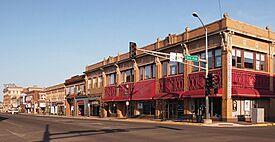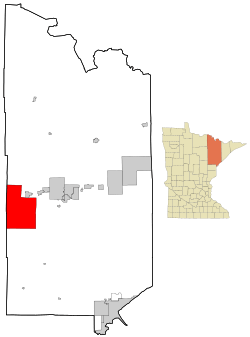Hibbing, Minnesota facts for kids
Quick facts for kids
Hibbing
|
|
|---|---|

East Howard Street in Hibbing
|
|
| Motto(s):
We're Ore And More.
|
|

Location of the city of Hibbing
within Saint Louis County, Minnesota |
|
| Country | United States |
| State | Minnesota |
| County | Saint Louis |
| Founded | 1893 |
| Area | |
| • Total | 186.46 sq mi (482.93 km2) |
| • Land | 182.03 sq mi (471.45 km2) |
| • Water | 4.43 sq mi (11.48 km2) |
| Elevation | 1,490 ft (454 m) |
| Population
(2020)
|
|
| • Total | 16,214 |
| • Estimate
(2022)
|
16,052 |
| • Density | 89.07/sq mi (34.39/km2) |
| Time zone | UTC−6 (Central (CST)) |
| • Summer (DST) | UTC−5 (CDT) |
| ZIP code |
55746
|
| Area code(s) | 218 |
| FIPS code | 27-28790 |
| GNIS feature ID | 0661469 |
| Sales tax | 7.375% |
Hibbing is a city in Saint Louis County, Minnesota, in the United States. About 16,214 people lived there in 2020. The city was built because of the rich iron ore found in the Mesabi Iron Range. Even today, mining is a very important activity for Hibbing.
At the edge of town, you can find the Hull–Rust–Mahoning Open Pit Iron Mine. It's the largest open-pit iron mine in the world! Hibbing is also famous as the hometown of several well-known people. These include singer-songwriter Bob Dylan, basketball star Kevin McHale, and former Minnesota Governor Rudy Perpich.
You can reach Hibbing using U.S. Highway 169, State Highway 37, or State Highway 73. The city is about 59 miles (95 km) northwest of Duluth, Minnesota.
Contents
Discovering Hibbing's Past
Hibbing was founded in 1893 by a man named Frank Hibbing. He was born in Germany in 1856. Frank came to America to find his fortune. He first worked on a farm and in a mill in Wisconsin.
Later, Frank moved to Duluth in 1887. He started a real estate business there. He also began exploring for minerals. In 1892, he led a group of thirty men into the wilderness. Frank was very good at finding iron ore. He soon found signs that there were huge amounts of ore hidden underground.
In July 1893, the town of Hibbing was officially created and named after him. Frank was very proud of the town's growth. He helped it develop by using his own money. He paid for the first water plant, electric lights, roads, a hotel, a sawmill, and a bank. Frank Hibbing passed away in 1897 at the age of 40.
The Birth of Greyhound Buses
In 1914, two men from Hibbing, Carl Wickman and Andrew "Bus Andy" Anderson, started a bus service. They drove people between Hibbing and a nearby town called Alice, Minnesota. This small bus line eventually grew into Greyhound Lines. Today, Greyhound is the largest bus transportation company in the world! You can visit the Greyhound Bus Museum in Hibbing. It even has the famous Scenicruiser bus, made just for Greyhound.
Moving an Entire Town
Hibbing grew very quickly because of the huge iron ore mines. Mines like Mahoning, Hull, Rust, Sellers, and Burt provided raw materials for America's factories. By 1915, about 20,000 people lived in Hibbing. But the mines kept growing. They started to get very close to the town. Miners even found that some of the valuable iron ore was right underneath the town!
So, the mining company and the town leaders made a plan. They decided to move the entire village! The new location was two miles south, near Alice. The mining company helped pay for new buildings in the downtown area. They also built new public buildings like Hibbing High School, the Androy Hotel, and the Village Hall.
Around 200 buildings were moved down the road to the new city. This included stores and even large hotels. The move started in 1919 and finished in 1921. The old area is now called "North Hibbing." The last house was moved from there in 1968.
In 1979, Hibbing grew even larger by adding the Town of Stuntz. This included several smaller communities. In January 1980, Hibbing officially became a city.
Exploring Hibbing's Geography
Hibbing covers a large area of about 186.46 square miles (482.93 km2). Most of this is land, with a small amount of water. McCarthy Beach State Park is also located nearby.
An interesting fact about Hibbing's geography is that it's near the Northern Divide. This is a special place where water flows in three different directions! Some water goes north to the Arctic Ocean. Some flows south to the Gulf of Mexico. And some goes east into the Great Lakes.
Hibbing's Climate
Hibbing has a climate with four distinct seasons. Summers are usually warm or hot. Winters are very cold, and they last a long time. It can even freeze in any month of the year!
| Climate data for Hibbing, Minnesota (Chisholm-Hibbing Airport), 1991–2020 normals, extremes 1938–present | |||||||||||||
|---|---|---|---|---|---|---|---|---|---|---|---|---|---|
| Month | Jan | Feb | Mar | Apr | May | Jun | Jul | Aug | Sep | Oct | Nov | Dec | Year |
| Record high °F (°C) | 51 (11) |
60 (16) |
80 (27) |
89 (32) |
95 (35) |
97 (36) |
98 (37) |
95 (35) |
95 (35) |
87 (31) |
72 (22) |
60 (16) |
98 (37) |
| Mean maximum °F (°C) | 38.0 (3.3) |
43.8 (6.6) |
57.5 (14.2) |
72.6 (22.6) |
83.6 (28.7) |
87.1 (30.6) |
88.7 (31.5) |
87.2 (30.7) |
83.2 (28.4) |
74.8 (23.8) |
54.6 (12.6) |
40.1 (4.5) |
90.4 (32.4) |
| Mean daily maximum °F (°C) | 16.9 (−8.4) |
22.5 (−5.3) |
35.4 (1.9) |
49.5 (9.7) |
63.4 (17.4) |
72.2 (22.3) |
76.7 (24.8) |
74.9 (23.8) |
65.7 (18.7) |
50.8 (10.4) |
34.3 (1.3) |
21.4 (−5.9) |
48.6 (9.2) |
| Daily mean °F (°C) | 6.2 (−14.3) |
10.5 (−11.9) |
23.8 (−4.6) |
37.1 (2.8) |
49.5 (9.7) |
58.9 (14.9) |
63.5 (17.5) |
61.6 (16.4) |
53.0 (11.7) |
40.2 (4.6) |
25.6 (−3.6) |
12.3 (−10.9) |
36.9 (2.7) |
| Mean daily minimum °F (°C) | −4.4 (−20.2) |
−1.4 (−18.6) |
12.2 (−11.0) |
24.8 (−4.0) |
35.7 (2.1) |
45.7 (7.6) |
50.3 (10.2) |
48.3 (9.1) |
40.3 (4.6) |
29.7 (−1.3) |
16.9 (−8.4) |
3.1 (−16.1) |
25.1 (−3.8) |
| Mean minimum °F (°C) | −29 (−34) |
−25.2 (−31.8) |
−14.2 (−25.7) |
10.6 (−11.9) |
23.4 (−4.8) |
32.2 (0.1) |
39.0 (3.9) |
36.7 (2.6) |
25.8 (−3.4) |
16.2 (−8.8) |
−3.6 (−19.8) |
−22.2 (−30.1) |
−32.5 (−35.8) |
| Record low °F (°C) | −50 (−46) |
−44 (−42) |
−37 (−38) |
−6 (−21) |
14 (−10) |
25 (−4) |
32 (0) |
27 (−3) |
20 (−7) |
0 (−18) |
−27 (−33) |
−38 (−39) |
−50 (−46) |
| Average precipitation inches (mm) | 0.51 (13) |
0.53 (13) |
0.91 (23) |
1.61 (41) |
2.76 (70) |
4.36 (111) |
3.85 (98) |
3.09 (78) |
3.06 (78) |
2.35 (60) |
1.09 (28) |
0.64 (16) |
24.76 (629) |
| Average snowfall inches (cm) | 15.0 (38) |
7.1 (18) |
7.8 (20) |
3.7 (9.4) |
0.0 (0.0) |
0.0 (0.0) |
0.0 (0.0) |
0.0 (0.0) |
0.0 (0.0) |
1.2 (3.0) |
13.2 (34) |
12.3 (31) |
60.3 (153) |
| Average precipitation days (≥ 0.01 in) | 7.2 | 5.0 | 6.4 | 8.1 | 12.0 | 13.1 | 11.5 | 10.7 | 12.0 | 11.1 | 8.0 | 7.8 | 112.9 |
| Average snowy days (≥ 0.1 in) | 10.9 | 6.9 | 5.9 | 3.0 | 0.2 | 0.0 | 0.0 | 0.0 | 0.1 | 1.5 | 7.3 | 10.6 | 46.4 |
| Source: NOAA (snow 1981–2010) | |||||||||||||
People of Hibbing
| Historical population | |||
|---|---|---|---|
| Census | Pop. | %± | |
| 1900 | 2,481 | — | |
| 1910 | 8,832 | 256.0% | |
| 1920 | 15,089 | 70.8% | |
| 1930 | 15,666 | 3.8% | |
| 1940 | 16,385 | 4.6% | |
| 1950 | 16,276 | −0.7% | |
| 1960 | 17,731 | 8.9% | |
| 1970 | 20,744 | 17.0% | |
| 1980 | 21,193 | 2.2% | |
| 1990 | 18,046 | −14.8% | |
| 2000 | 17,071 | −5.4% | |
| 2010 | 16,361 | −4.2% | |
| 2020 | 16,214 | −0.9% | |
| 2022 (est.) | 16,052 | −1.9% | |
| U.S. Decennial Census 2020 Census |
|||
In 2020, the population of Hibbing was 16,214 people. Most residents (about 91.3%) were White. About 1.5% were Black or African American, and 0.9% were Native American. About 1.6% of the population was of Hispanic or Latino background.
In 2010, there were 16,361 people living in Hibbing. About 26.3% of households had children under 18. The average age in the city was 42.5 years old.
Education in Hibbing
Hibbing is home to Hibbing Community College. This is a two-year college where students can earn degrees and learn job skills.
Media and News
Hibbing has several radio stations, including WMFG and WHPJ. There are also TV stations like KRII and WIRT-DT. The local newspaper, the Hibbing Daily Tribune, started in 1893. In 2020, it joined with another paper to become the Mesabi Tribune.
Famous Faces from Hibbing
Many talented people have come from Hibbing! Here are a few:
- Bob Dylan: A world-famous musician and songwriter. He won the Nobel Prize in Literature in 2016. His boyhood home is in Hibbing.
- Kevin McHale: A legendary professional basketball player. He won three NBA championships with the Boston Celtics. He is considered one of the 50 greatest players in NBA history.
- Rudy Perpich: A dentist from Hibbing who became the Governor of Minnesota for two terms.
- Roger Maris: A professional baseball player who famously broke Babe Ruth's record for most home runs in a single season.
- Carl Wickman: The founder of Greyhound Lines, the huge bus company.
- Jeno Paulucci: The person who started the popular food brands Jeno's Pizza and Chun King Foods.
- Gary Puckett: The lead singer of the 1960s band Gary Puckett and the Union Gap.
Sister Cities
Hibbing has a special connection with one city in Germany:
- Walsrode, Lower Saxony (Germany)
See also
 In Spanish: Hibbing para niños
In Spanish: Hibbing para niños


